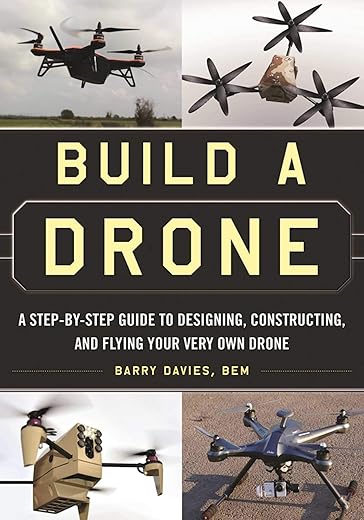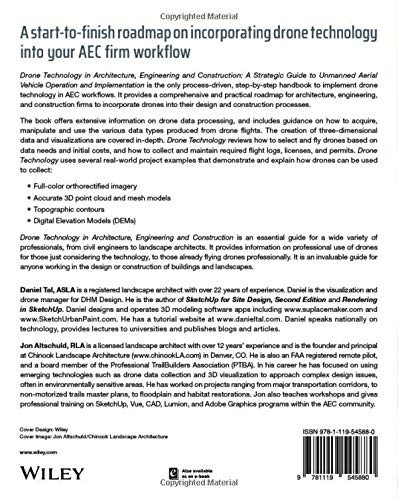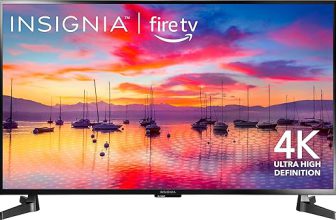
In exploring the evolving landscape of drone technology, I find myself drawn to two distinct resources: the “Build a Drone Guide” and the “Drone AEC Strategy Guide.” Each guide offers unique insights tailored to different aspects of drone utilization. While the former focuses on the practicalities of constructing a drone and understanding its components, the latter delves into strategic applications within the architecture, engineering, and construction (AEC) sectors. By examining their contents, I aim to highlight how these guides cater to varying needs and audiences within the expanding field of drone use.
Drone Enthusiasts

Build a Drone: A Step-by-Step Guide to Designing, Constructing, and Flying Your Very Own Drone” teaches readers how to construct and operate drones safely, catering to both recreational and professional uses. Authored by expert Barry Davies, this comprehensive guide covers everything from design to maintenance, highlighting the growing significance of drones in various sectors.
Drone AEC Strategy Guide

Drone Technology in Architecture, Engineering and Construction” is a comprehensive handbook that offers a step-by-step roadmap for integrating drone technology into AEC workflows. It provides practical guidance on data processing, drone operation, and real-world applications, making it an essential resource for professionals in the industry.
Build a Drone Guide
Target Audience
General audience interested in building and flying drones for recreational and various practical uses.
Focus of Content
Emphasizes the construction, maintenance, and safe operation of drones with a historical context.
Technical Depth
Includes hands-on building instructions and safety guidelines for drone flight.
Real-World Applications
Discusses a variety of drone applications from hobbyist to professional uses, including military history.
Author Expertise
Written by Barry Davies, an expert with experience in building drones for DARPA and MIT.
Drone AEC Strategy Guide
Target Audience
Professionals in architecture, engineering, and construction looking to incorporate drone technology into their workflows.
Focus of Content
Provides a structured approach to implement drone technology specifically within AEC processes, focusing on data collection and analysis.
Technical Depth
Offers detailed information on drone data processing, including three-dimensional data creation and visualization techniques.
Real-World Applications
Features real-world project examples demonstrating practical applications of drones in AEC, including data integration with existing models.
Author Expertise
Compiled by professionals knowledgeable in AEC and drone technology, providing insights specific to industry needs.
Build a Drone Guide
Drone AEC Strategy Guide
Build a Drone Guide
Drone AEC Strategy Guide
Comparison table


Comparison Table
Unique Selling Points (USPs)
Build a Drone: A Step-by-Step Guide
- Hands-on approach for DIY enthusiasts.
- Customization options for personalized drones.
- Clear illustrations and instructions for easy understanding.
Drone Technology in Architecture, Engineering and Construction
- Comprehensive strategic guide for industry professionals.
- Real-world case studies showcasing successful implementations.
- Focus on enhancing project efficiency and compliance.
Similarities
- Both products involve drone technology but cater to different audiences.
- Each provides valuable insights into drone operation.
- Both can enhance understanding and skills related to drone usage.
Pros and Cons
Build a Drone: A Step-by-Step Guide
Pros:
- Affordable for hobbyists.
- Encourages learning through practical experience.
- Offers flexibility in design and functionality.
Cons:
- May not meet professional standards for advanced applications.
- Limited guidance on regulatory compliance.
Drone Technology in Architecture, Engineering and Construction
Pros:
- Tailored for professionals, enhancing workplace efficiency.
- Addresses compliance and industry standards.
- Includes strategic insights and operational planning.
Cons:
- Higher initial investment required.
- Requires a more advanced understanding of drone technology.
Use Cases
Build a Drone: A Step-by-Step Guide
- Ideal for hobbyists looking to create and fly their own drones.
- Suitable for educational purposes in schools or workshops.
- Great for those interested in exploring technology and engineering.
Drone Technology in Architecture, Engineering and Construction
- Perfect for professionals looking to integrate drones into their workflow.
- Useful for project managers and engineers assessing site conditions.
- Applicable in surveys, inspections, and monitoring construction progress.
Conclusive Assessment
There is no absolute winner between these two products as they serve distinct markets and needs.
- Build a Drone: A Step-by-Step Guide excels in hands-on learning for DIY enthusiasts and hobbyists, making it a suitable choice for those who prefer a practical approach and customization.
- Drone Technology in Architecture, Engineering and Construction is superior for professionals seeking to implement drone technology strategically within the AEC industry, focusing on compliance and operational efficiency.
Final Summary
In summary, your choice between “Build a Drone: A Step-by-Step Guide” and “Drone Technology in Architecture, Engineering and Construction” should hinge on your specific needs. If you are a hobbyist or a DIY enthusiast eager to learn and create, the first option is your best bet. Conversely, if you are a professional in the AEC field looking to enhance project efficiency and integrate advanced drone technology, the second option is more aligned with your goals.
Exploring Innovative Drone Solutions









Totally agree! Both guides have their strengths, but I feel like if you’re looking for practical applications, the Drone AEC Strategy Guide is more robust. It’s really tailored for professionals.
I’ve gotta say, the Build a Drone Guide is a game changer for beginners! It’s super easy to follow and really helped me get started. Highly recommend it!
Thanks for the recommendation! It’s great to hear that the Build a Drone Guide is working well for you. What specific part did you find most helpful?
For anyone looking to get into drone racing, I’d suggest checking out some racing-specific guides too. Not quite the same, but super fun!
Thanks for the tip! Racing does have a different focus, but it’s definitely an exciting area of drone technology.
I’ve been using drones for surveying, and the tips in the Drone AEC Strategy Guide have seriously improved my workflow. Anyone else using drones in construction?
I actually had a rough start with drones, but the Build a Drone Guide laid a solid foundation. I learned a lot about safety and regulations, which saved me a ton of headaches later on! Anyone else have similar experiences?
That’s awesome to hear! Safety and regulations are so important. Did you find any particular section in the guide that stood out?
I’ve tried both guides, and I prefer the Drone AEC Strategy Guide for its detailed case studies. They give real-world context that you don’t get everywhere. What are your thoughts on that?
Great point! The real-world applications in the Drone AEC Strategy Guide can be really enlightening. Glad you found value in it!
Could you dive a bit deeper into the comparison of the cost-effectiveness of both guides? I’m curious how they stack up in terms of value for money.